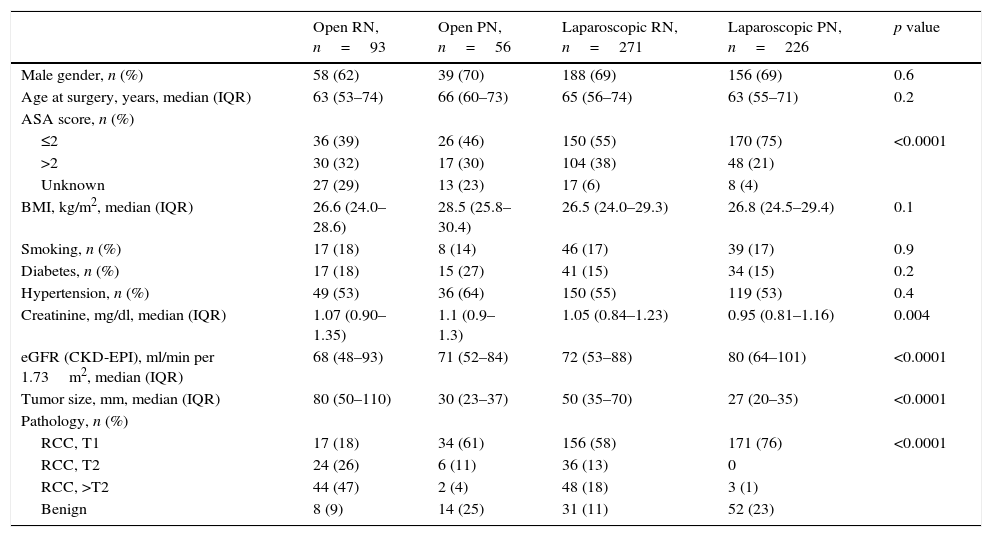To describe the temporal trends in surgical techniques for the management of renal masses at a single Spanish academic institution and identify factors associated with partial nephrectomy (PN) decision.
Materials and methodsA total of 646 patients were treated by surgery for clinically localized renal masses from January 2004 to December 2012 at a tertiary referral center. Surgical techniques included open radical nephrectomy (RN), open PN, laparoscopic RN, and laparoscopic PN. Descriptive statistics were used to compare baseline characteristics and proportions of patients treated by different surgical techniques. Annual trends in the proportion of procedures performed were determined. Adjusted odds ratios (OR) and 95% confidence intervals were calculated to evaluate clinical variables predictive of PN.
ResultsDuring the 9-year study period, the proportion of PN relative to RN increased from 21% to 55%. With regard to surgical approach, open procedures for both RN and PN decreased gradually in favor of minimally invasive approaches (83% in 2004 to 4% in 2011–2012). While median tumor size did not significantly change over the study period, laparoscopic PN became the most commonly performed kidney procedure in 2011–2012 (49% of all procedures). Clinical variables independently predictive of partial nephrectomy were ASA score, baseline renal function and tumor size (all p<0.05).
ConclusionsAt our academic institution, temporal trends in the management of renal masses have established PN as the most common surgical option. Although PN was increasingly used over the study period, a parallel increase in minimally invasive approaches for RN and PN was seen.
Describir la evolución de la técnica quirúrgica para el manejo de las masas renales en un centro español e identificar los factores asociados con la decisión de nefrectomía parcial (NP).
Materiales y métodosUn total de 646 pacientes fueron tratados quirúrgicamente por tumores renales localizados entre enero de 2004 y diciembre de 2012. Las técnicas quirúrgicas incluyeron la nefrectomía radical (NR) abierta, NP abierta, NR laparoscópica y NP laparoscópica. Se compararon las características basales y las proporciones de los pacientes tratados por diferentes técnicas mediante estadísticos descriptivos y se determinaron las tendencias anuales en la proporción de procedimientos realizados. Se calculó la proporción de probabilidades (OR) y los intervalos de confianza del 95% para evaluar variables clínicas predictivas de NP.
ResultadosDurante el período de 9 años, la proporción de NP aumentó respecto a la NR, pasando del 21 al 55%. Los procedimientos abiertos disminuyeron gradualmente a favor de abordajes mínimamente invasivos (83% en 2004; 4% en 2011-2012). Aunque el tamaño tumoral medio no cambió significativamente durante el período de estudio, la NP laparoscópica se convirtió en el procedimiento más realizado en 2011-2012 (un 49% de todos los procedimientos). Las variables clínicas independientemente predictivas de NP fueron puntuación ASA, función renal basal y tamaño tumoral (todas las p<0,05).
ConclusionesEn nuestra institución, la evolución en el manejo de las masas renales ha establecido la NP como la opción quirúrgica más frecuente. Aunque la NP se utilizó cada vez más durante el período de estudio, se observó un aumento paralelo de los abordajes mínimamente invasivos tanto para NR como para NP.










